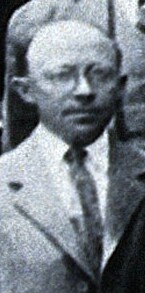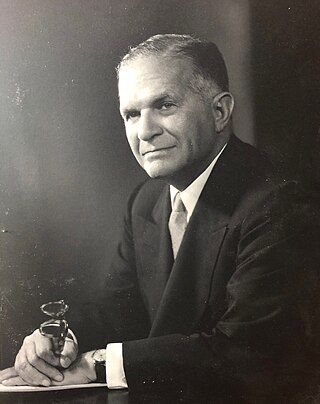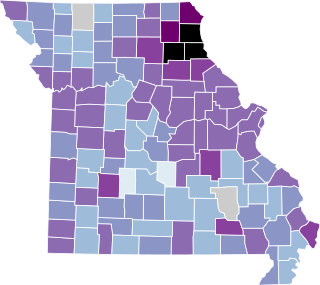Related Research Articles

The Centers for Disease Control and Prevention (CDC) is the national public health agency of the United States. It is a United States federal agency under the Department of Health and Human Services, and is headquartered in Atlanta, Georgia.

Washington University in St. Louis is a private research university with its main campus in St. Louis County, Missouri. Founded in 1853, the university is named after George Washington, a Founding Father, commanding general of the Continental Army, and the first president of the United States.

The smallpox vaccine is the first vaccine to have been developed against a contagious disease. In 1796, British physician Edward Jenner demonstrated that an infection with the relatively mild cowpox virus conferred immunity against the deadly smallpox virus. Cowpox served as a natural vaccine until the modern smallpox vaccine emerged in the 20th century. From 1958 to 1977, the World Health Organization (WHO) conducted a global vaccination campaign that eradicated smallpox, making it the only human disease to be eradicated. Although routine smallpox vaccination is no longer performed on the general public, the vaccine is still being produced to guard against bioterrorism, biological warfare, and mpox.

Julius Dassin was an American film and theatre director, producer, writer and actor. A subject of the Hollywood blacklist, he subsequently moved to France, and later Greece, where he continued his career. He was a member of the Academy of Motion Picture Arts and Sciences and the Screen Directors' Guild.

Arthur Kornberg was an American biochemist who won the Nobel Prize in Physiology or Medicine 1959 for the discovery of "the mechanisms in the biological synthesis of ribonucleic acid and deoxyribonucleic acid" together with Spanish biochemist and physician Severo Ochoa of New York University. He was also awarded the Paul-Lewis Award in Enzyme Chemistry from the American Chemical Society in 1951, an L.H.D. degree from Yeshiva University in 1962, and the National Medal of Science in 1979. In 1991, Kornberg received the Golden Plate Award of the American Academy of Achievement and the Gairdner Foundation Award in 1995.

Donald Ainslie Henderson was an American medical doctor, educator, and epidemiologist who directed a 10-year international effort (1967–1977) that eradicated smallpox throughout the world and launched international childhood vaccination programs. From 1977 to 1990, he was Dean of the Johns Hopkins School of Public Health. Later, he played a leading role in instigating national programs for public health preparedness and response following biological attacks and national disasters. At the time of his death, he was Professor and Dean Emeritus of the Johns Hopkins Bloomberg School of Public Health, and Professor of Medicine and Public Health at the University of Pittsburgh, as well as Distinguished Scholar at the UPMC Center for Health Security.

Dwight Filley Davis Sr. was an American tennis player and politician. He is best remembered as the founder of the Davis Cup international tennis competition. He was the Assistant Secretary of War from 1923 to 1925 and Secretary of War from 1925 to 1929.

Washington University School of Medicine (WUSM) is the medical school of Washington University in St. Louis, a private research university with its main campus in St. Louis County, and Clayton, Missouri. Founded in 1891, the School of Medicine shares a campus with Barnes-Jewish Hospital, Alvin J. Siteman Cancer Center, and Central Institute for the Deaf. It has consistently ranked among the top medical schools in the United States in terms of the number/amount of research grants/funding awarded by the National Institutes of Health, among other measures.
Geoffrey Lilley Smith FRS FMedSci FRSB is a British virologist and medical research authority in the area of Vaccinia virus and the family of Poxviruses. Since 1 October 2011 he is head of the Department of Pathology at the University of Cambridge and a principal research fellow of the Wellcome Trust. Before that, he was head of the Department of Virology at Imperial College London.

John Henry Rauch was an American sanitarian. He brought attention to public health problems posed by cemeteries in large cities and handled the public health emergencies posed by the Chicago fire of 1871. He was the founding president of the Illinois State Board of Health.

Michael Lynn Parson is an American politician serving as the 57th governor of Missouri since 2018. A member of the Republican Party, Parson assumed the governorship when Eric Greitens resigned, as he was lieutenant governor at the time. Parson served the remainder of Greitens's term and was elected governor in his own right in 2020.
The Public Health Research Institute (PHRI) was founded in 1942 by New York City's mayor, Fiorello La Guardia, who appointed David M. Heyman to lead it as an independent not-for-profit research organization. In the late 1980s it was referred to as Public Health Research Institute - New York In 2002, they moved to Newark, New Jersey. PHRI became part of the New Jersey Medical School in 2006 and since 2013 it has been part at Rutgers University.
The 1947 New York City smallpox outbreak occurred in March 1947 and was declared ended on April 24, 1947. The outbreak marked the largest mass vaccination effort ever conducted for smallpox in America. Within three weeks of the discovery of the outbreak, the U.S. Public Health Service, in conjunction with New York City health officials, had procured the smallpox vaccine and inoculated over 6,350,000 adults and children. Of that number, 5,000,000 had been vaccinated within the first two weeks. The rapid response was credited with limiting the outbreak to 12 people, 10 of whom recovered, while 2 died.

Israel Jacob Kligler was a microbiologist. A Zionist and humanist, he was born in the Austro-Hungarian Empire, educated in the United States and spent most of his career in Mandatory Palestine, but died before the creation of the State of Israel. He was one of the first four professors of the Hebrew University and the founder of Department of Hygiene and Bacteriology of the university, which he headed until his death in 1944. Kligler was one of the pioneers of modern medical research in Mandatory Palestine, studying as varied a field as Bacteriology, Parasitology, Virology, Nutrition, Epidemiology and Public Health. He developed the Kligler Iron Agar medium for the isolation and identification of intestinal bacteria, which is still in use today.

Jesus C. Azurin was a Filipino medical doctor who was the Philippines’ Minister of Health from July 1981 to February 1986. In 1985, he was the recipient of the first Sasakawa Prize awarded by the World Health Organization (WHO) for achievements in the public health field. At the 38th World Health Assembly on May 9, 1985 at the Palais des Nations, Geneva, Switzerland, Dr. Azurin was cited for accomplishments that "have been recognized nationally and internationally". Among several specific achievements mentioned in the Award's citation were that "Dr. Azurin personally initiated and promoted a series of innovative mesures to make primary health care a reality in the Philippines", that he "reorganized the Ministry of Health in order to decentralize its activities" and "vigorously supported... community projects to bring essential drugs within the reach of the population at an affordable cost", and that he pioneered in the effort that "led to the establishment of a research institute for tropical medicine in Manila, as a support to the Ministry's programme to control communicable diseases".
The Commissioner of Health of the City of New York is the head of the city's Department of Health and Mental Hygiene. The commissioner is appointed by the Mayor of New York City, and also serves on the city's Board of Health with the chairperson of the Department's Mental Hygiene Advisory Board and nine other members appointed by the mayor.

David Melville Heyman was an American financier, health services leader, philanthropist, and art collector. Heyman founded the Public Health Research Institute of the City of New York in 1942 and the Health Insurance Plan of Greater New York in 1944, and served as the president of the New York Foundation for thirty years.

The COVID-19 pandemic was confirmed to have reached the U.S. state of Missouri in March 2020. A university student who had recently been to Italy, was the first index case for COVID-19 in Missouri. She was treated at Mercy Hospital St. Louis. As of February 8, 2021, the Missouri Department of Health and Senior Services has confirmed 502,432 cumulative cases and 7,562 deaths.
Israel Weinstein was an American physician and bacteriologist, best known for his work in public health in New York City, especially during the 1947 New York City smallpox outbreak as the Commissioner of Health of the City of New York from March 13, 1946, to November 3, 1947, under Mayor William O'Dwyer.

The 2022–2023 mpox outbreak in the United States is part of the larger outbreak of human mpox caused by the West African clade of the monkeypox virus. The United States was the fourth country outside of the African countries with endemic mpox, to experience an outbreak in 2022. The first case was documented in Boston, Massachusetts, on May 17, 2022. As of August 22, mpox has spread to all 50 states in the United States, as well as Washington, D.C., and Puerto Rico. The United States has the highest number of mpox cases in the world. California has the highest number of mpox cases in the United States.
References
- ↑ 1940 census: age 24
- ↑ Heyman, D. M. (1942). "Annual Report of the Public Health Research Institute of the City of New York, Inc.: July 1, 1941 - June 30, 1942". Public Health Research Institute. Archived from the original on January 30, 2011. Retrieved May 13, 2021.
PHRI's First Annual Report 1941-1942
{{cite web}}: CS1 maint: unfit URL (link) - ↑ "History of the Missouri Branch, American Society for Microbiology". American Society for Microbiology Branch Histories. January 2002. Archived from the original on May 14, 2021. Retrieved May 14, 2021.
- 1 2 "PHYSICIANS HERE SPURN $6,000 POST; Dr. R.S. Muckenfuss of St. Louis Appointed to Job Local Doctors Refused". New York Times . July 11, 1935. Archived from the original on May 14, 2021. Retrieved May 14, 2021.
- ↑ RS Muckenfuss (1933). "Encephalitis: Studies on Experimental Transmission". Public Health Reports. 48 (44): 1341–1343. doi:10.2307/4580968. JSTOR 4580968. S2CID 79878352. Archived from the original on May 14, 2021. Retrieved May 14, 2021.
RALPH S. MUCKENFUSS, Assistant Professor of Medicine, Washington University School of Medicine, St. Louis
- 1 2 Jimmy Breslin (November 19, 2002). "Saving Public From The Pox". Newsday . Archived from the original on May 14, 2021. Retrieved May 14, 2021.
scrapbook kept by the Department of Health during the 1947 smallpox fright in New York
- ↑ "NO EPIDEMIC OF FLU IS REPORTED IN CITY; Rise in Illness Is Not Unusual for Time of Year, Health Department Aide Says". New York Times . January 24, 1953.
- ↑ Lawrence K. Altman (March 21, 1977). "Disease Expert Sees Threat Of Germ War". New York Times . Archived from the original on May 14, 2021. Retrieved May 14, 2021.